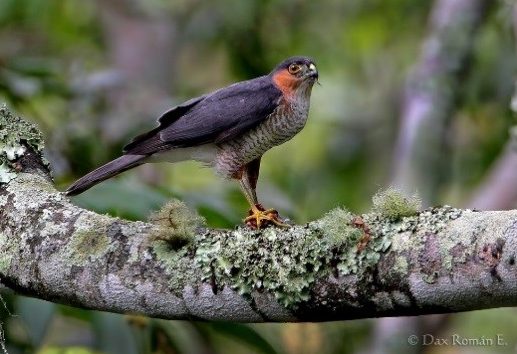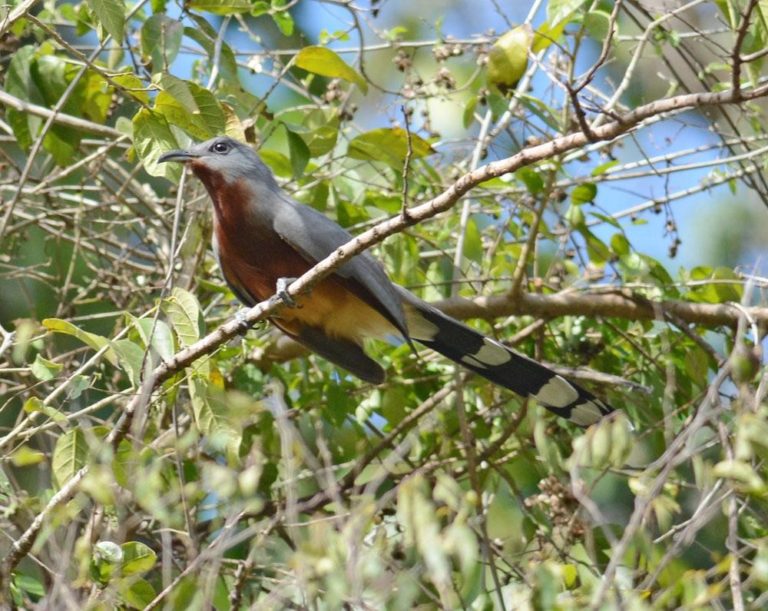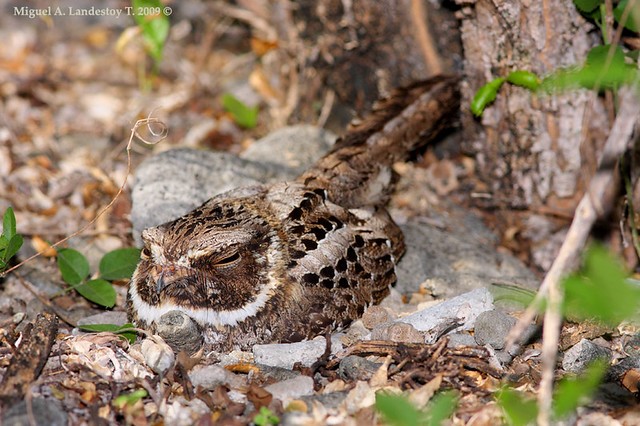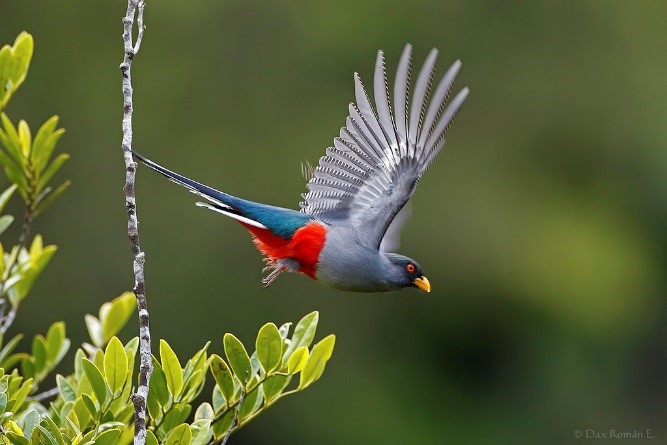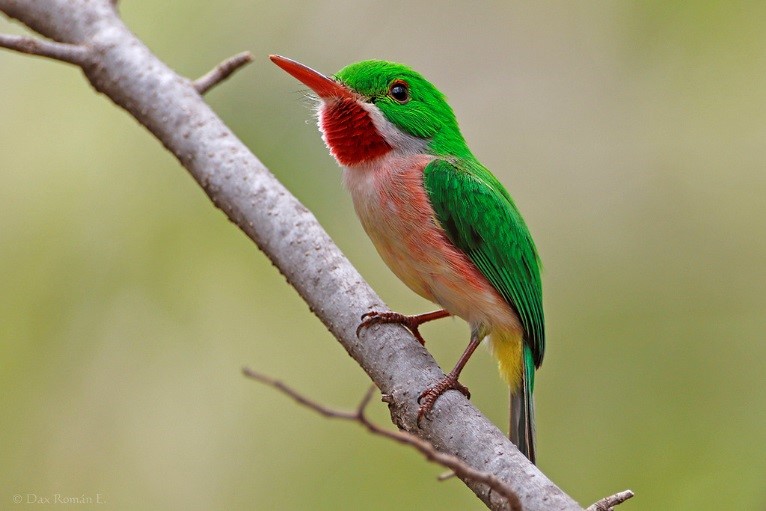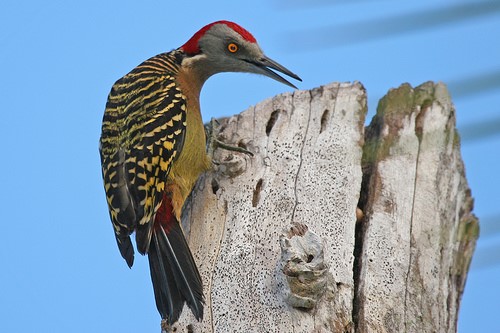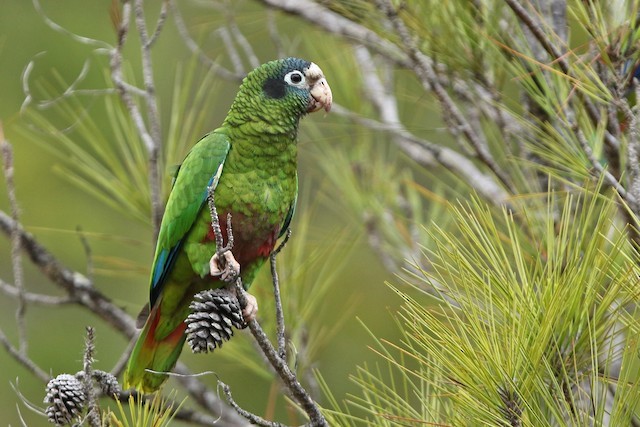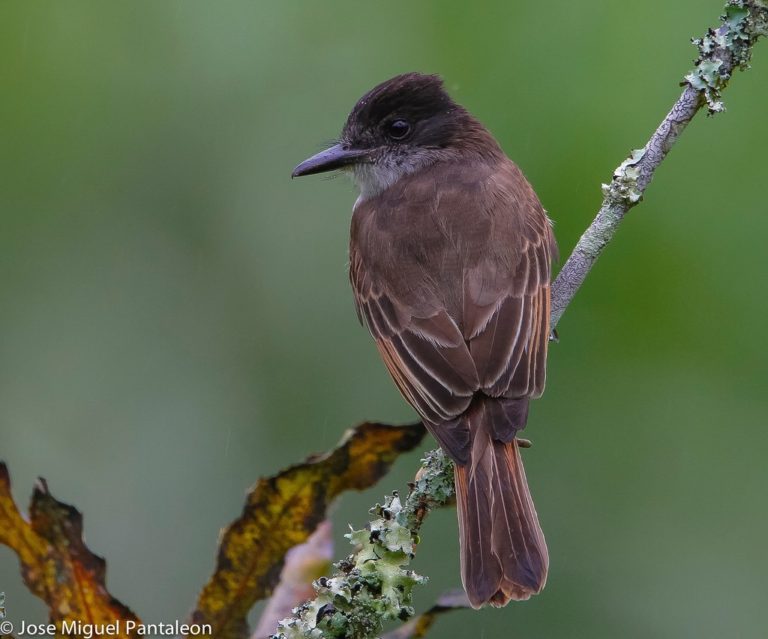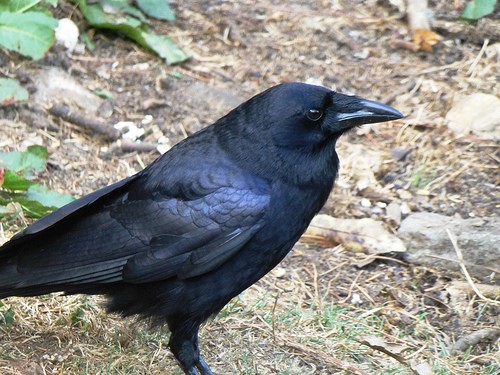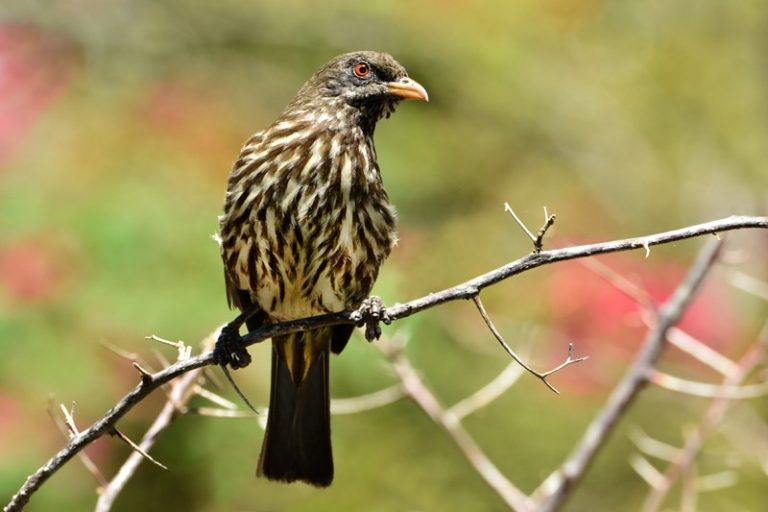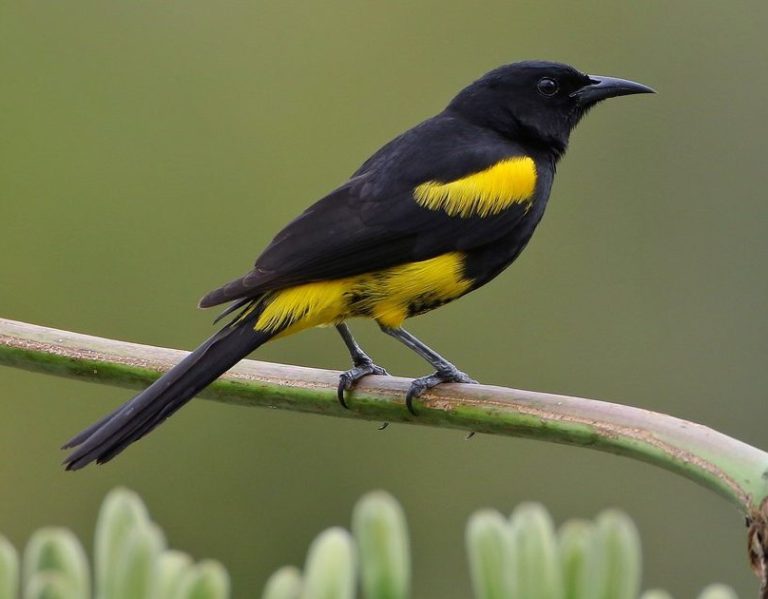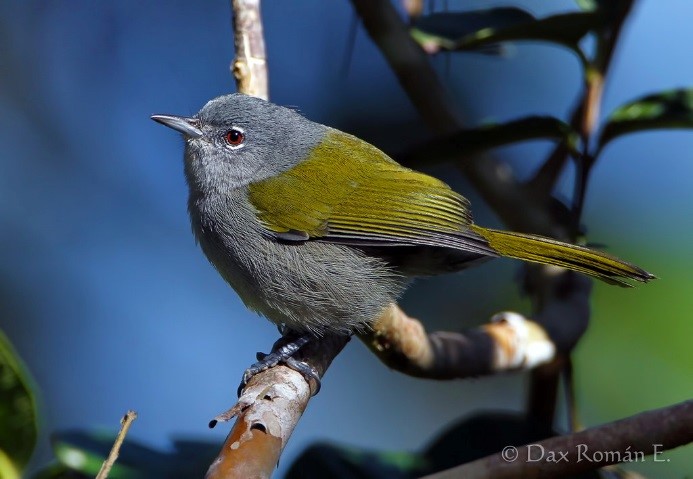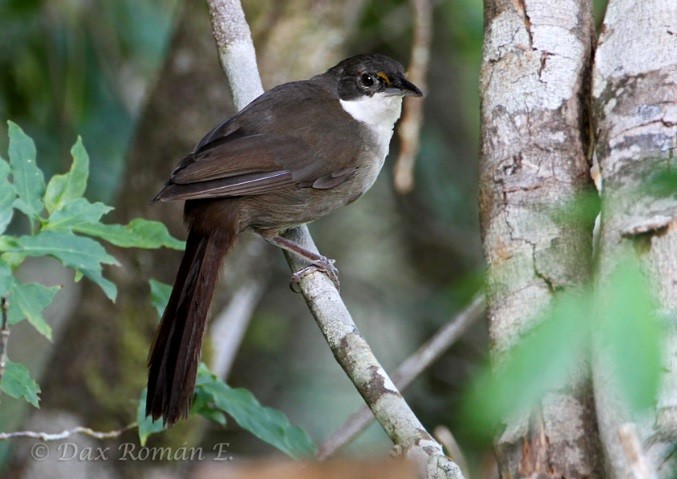
Hispaniolan Trogon. © Dax M. Román E.
Situated at the center of the West Indies, Hispaniola is also the center of its avian endemism, with approximately 36 species and three families found nowhere else. This is due in part to its size, as it is the only Caribbean island with a deep interior, and to the diversity of its landscapes, which include the tallest mountains in the region and the widest range of habitats, from deserts to cloud forests.
Conveniently for visiting birdwatchers, all of Hispaniola’s major habitats and all but two of its endemics can be found in the southwestern corner of the Dominican Republic, where a two-hour drive separates the sweltering flats of the Enriquillo Basin from the crisp mountain air of the Sierra de Bahoruco. The remaining two endemics, Ridgway’s Hawk and Gray-crowned Palm-Tanager, have historically been reported from this area, but not reliably in recent years. (For orientation to the main birdwatching sites in Dominican Republic, see the map below or go to The Avitourist’s Guide to the Dominican Republic.)
Endemic Birds of Hispaniola
Ridgway’s Hawk / “Hispaniolan Sharp-shinned Hawk” / White-fronted Quail-Dove / Bay-breasted Cuckoo / Hispaniolan Lizard-Cuckoo / Ashy-faced Owl / “Hispaniolan Burrowing Owl” / Least Pauraque / Hispaniolan Nightjar / Hispaniolan Mango / Hispaniolan Emerald / Hispaniolan Trogon / Narrow-billed Tody / Broad-billed Tody / Antillean Piculet / Hispaniolan Woodpecker / “Hispaniolan Kestrel” / Hispaniolan Parrot / Hispaniolan Parakeet / Hispaniolan Elaenia / Hispaniolan Pewee / Hispaniolan Kingbird / Flat-billed Vireo / Hispaniolan Palm Crow / White-necked Crow / Golden Swallow / La Selle Thrush / Palmchat / Hispaniolan Crossbill / Antillean Siskin / Hispaniolan Euphonia / Hispaniolan Oriole / Black-crowned Palm-Tanager / Gray-crowned Palm-Tanager / White-winged Warbler / Green-tailed Warbler / Hispaniolan Spindalis / Western Chat-Tanager / Eastern Chat-Tanager
Ridgway’s Hawk (Buteo ridgwayi): Endemic to Hispaniola and now confined to the eastern D.R. Rare in terms of numbers, but not hard to find. It is readily observed behind the Paraíso Caño Hondo ecolodge at the eastern corner of Los Haitises National Park, and in the southwestern corner of the park near the village of Los Limones. Near Punta Cana, birds from the transplanted population can be seen at the Punta Cana Ecological Reserve and sometimes on the grounds of resorts.
“Hispaniolan Sharp-shinned Hawk” (Accipiter striatus striatus): A localized endemic form of Sharp-shinned Hawk, the least endangered of the three West Indian forms. Most numerous in the Cordillera Central and Sierra de Bahoruco. Sites where it can often be found include Ébano Verde, Zapotén, Los Arroyos, Alcoa Road, and the Rabo de Gato Trail.
White-fronted Quail-Dove (Geotrygon leucometopia): This beautiful endemic dove is rare and endangered, but still locally common in the Sierra de Bahoruco. It is most readily observed in “Quail-Dove Alley” on the Rabo de Gato Trail and along Zapotén Road in the stretch below Zapotén—where it is often possible to see several on the road at first light. Can also be found in the cloud forest at Cachote and at Ébano Verde.
Bay-breasted Cuckoo (Coccyzus rufigularis): Endangered and highly localized. Most readily found along Zapotén Road between La Placa and El Aguacate, where it remains fairly common. Can also be found at times in the highland forest zone of Zapotén and along the Rabo de Gato Trail. This spectacular and highly sought-after species has a reputation for shyness that may be undeserved. It seems to move slowly and deliberately across a large area. When encountered, it often allows a close, clear view, studying the observer with apparent curiosity before continuing on its way.
Hispaniolan Lizard-Cuckoo (Coccyzus longirostris): A common species that may be encountered nearly anywhere on Hispaniola, including all the frequently visited sites. Can often be found at the National Botanical Garden in Santo Domingo, and in the vicinity of the major seaside resorts.
Ashy-faced Owl (Tyto glaucops): Locally common across much of Hispaniola. Likely occurs at higher densities around limestone slopes and outcrops where it uses natural caves for nesting. One perennially reliable site is the road to Paraíso Caño Hondo at Sabana de la Mar. It can sometimes be found in developed areas with many palm trees, including Punta Cana. Other areas where this species has been regularly reported include: the Monte Plata palm plantations, middle elevations of Alcoa Road, the trail at La Placa, and side-roads leading inland from Route 44 between Barahona and Oviedo (including the road up to Cachote).
“Hispaniolan Burrowing Owl” (Athene cunicularia troglodytes): An insular form of Burrowing Owl that is common in the southwestern D.R., especially in the foothills of the Sierra de Bahoruco and adjacent plains, but otherwise rare and local. Sites where it is reliably found include Puerto Escondido, La Placa, lower elevations of Alcoa Road and the road to Los Arroyos, and south of Barahona. In the northern D.R. it can be found at Monte Cristi National Park.
Least Pauraque (Siphonorhis brewsteri): One of Hispaniola’s least-known endemics, found mainly in the southwestern D.R. Sites where it can reliably be heard—and, with effort and luck, seen—after dark include Zapotén Road below La Placa, the Rabo de Gato Trail (sometimes within the Villa Barrancolí compound), and side roads that lead up into the hills above Route 44 between Barahona and La Ciénaga. There have been recent reports from the northern coast in vicinity of Puerto Plata.
Hispaniolan Nightjar (Antrostomus ekmani): An uncommon, local, and little-known Hispaniolan endemic that is most readily observed in the mixed forest zone of Alcoa Road, where several males can often be heard calling at once. Also frequently heard along Zapotén Road, particularly in the stretch above La Placa, but limited access and denser habitat make observation more challenging there than on Alcoa Road. Other sites where it can sometimes be found include the Rabo de Gato Trail, the foothills below Cachote, and a few locations in the Cordillera Central, such as Valle Nuevo National Park.
Hispaniolan Mango (Anthracothorax dominicus): Traditionally considered conspecific with Puerto Rican Mango, together comprising the Antillean Mango, but they are distinct in size, proportions, and plumage, and seem certain to be ultimately classified as separate species. It is widespread and easy to find across Hispaniola. Can be found in coastal resort areas, such as Punta Cana, and in urban areas, including Santo Domingo, where it is usually present in the National Botanical Garden. In the southwestern D.R., it is most likely to be found along the coast from Barahona south, or in scrub or dry forest: e.g., along the Rabo de Gato Trail.
Hispaniolan Emerald (Chlorostilbon swainsonii): Common in montane forests, woodlands, and scrub—descends into some lowland areas during winter. It can usually be found in numbers at upper elevations of Zapotén Road, Los Arroyos, and the mixed forest section of Alcoa Road. Also at various other sites, including the Rabo de Gato Trail, Cachote, and throughout the Cordillera Central.
Hispaniolan Trogon (Priotelus roseigaster): Locally common in the mountains of Hispaniola. In the D.R. it can usually be found at sites such as Zapotén, Los Arroyos, Cachote, and Ébano Verde. In Haiti, the accessible locations are Pic Macaya and La Visite National Park.
Narrow-billed Tody (Todus angustirostris): Common in humid montane forests, and locally uncommon in other types of woodlands and at lower elevations. Known from all the major mountain ranges of Hispaniola and some hilly lowland areas in the east: e.g., Los Haitises National Park and the Samaná Peninsula. Usually easy to find at montane forest sites of the D.R. such as Zapotén, the middle section of Alcoa Road, Cachote, and Ébano Verde Scientific Reserve. Can sometimes be found along the Rabo de Gato Trail, side-by-side with Broad-billed Tody. In Haiti, easily found at Pic Macaya and La Visite National Park.
Broad-billed Tody (Todus subulatus): The more common and widespread of Hispaniola’s two todies, it can usually be found at sites such as the National Botanical Garden in Santo Domingo, the Rabo de Gato Trail, Los Haitises and Del Este National Parks, and the scrubland beside Lago Enriquillo. It can also be found in the vicinity of the major resorts in the eastern D.R., as at Punta Cana and La Romana.
Antillean Piculet (Nesoctites micromegas): Widespread in an array of wooded habitats at most elevations, including montane pine forests, dry forests, humid lowland forests, dry scrub, and mangroves. Locally common in some areas, but inexplicably rare or sporadic in many areas of apparently suitable habitat. Among the frequently visited sites, the most reliable seem to be the middle elevations of Zapotén Road and Los Haitises National Park (both Paraíso Caño Hondo and Los Limones). In Haiti, most numerous on Gonâve Island and at Pic Macaya Biosphere Reserve; rare in La Visite National Park.
Hispaniolan Woodpecker (Melanerpes striatus): Very common, conspicuous, and easy to find throughout Hispaniola, wherever there are trees, including Santo Domingo and coastal resort areas. Among the most ubiquitous of Hispaniola’s endemic birds.
“Hispaniolan Kestrel” (Falco sparverius dominicensis): An insular form of American Kestrel that is very common, conspicuous, and easy to find throughout Hispaniola. Among the most ubiquitous of Hispaniola’s endemic birds.
Hispaniolan Parrot (Amazona ventralis): Patchily distributed, mainly in mountain forests, dispersing over a wider range of habitats to feed. In the southwestern D.R., it is readily found in the upper and middle sections of Alcoa Road. Somewhat less consistent at Zapotén, La Placa, the Rabo de Gato Trail, and Cachote. In the Cordillera Central, Ébano Verde is a reliable site. The resorts around Punta Cana are among the most likely places to find it.
Hispaniolan Parakeet (Psittacara chloropterus): Uncommon and declining overall, but locally common in Santo Domingo and around Punta Cana, La Romana, and Cap-Haitien. Most readily found within Santo Domingo itself: especially at the National Botanical Garden and the Parque Mirador del Sur. In the southwestern D.R. it can often be found in the mixed forest section of Alcoa Road and at Cachote.
Hispaniolan Elaenia (Elaenia cherriei): Common in montane forests, especially open pine woods. Easy to find at upper elevations of Zapotén and Alcoa Road. Also common at various sites in the Cordillera Central, including Ébano Verde Scientific Reserve. Occasionally reported from some lowland sites, including Los Haitises National Park.
Hispaniolan Pewee (Contopus hispaniolensis): Widespread and generally common in forests, open woodlands, and tall scrub at all elevations. Easy to find at wooded sites in the southwestern and central D.R., such as Alcoa Road, Los Arroyos, Zapotén, Cachote, the Rabo de Gato Trail, El Valle National Park, and Ébano Verde Scientific Reserve. In the eastern D.R., it can generally be found in tracts of intact forest, such as Los Haitises and Del Este National Parks and the Punta Cana Ecological Reserve.
Hispaniolan Kingbird (Tyrannus gabbii): Traditionally considered a subspecies of Loggerhead Kingbird, but differences in plumage and vocalizations suggest that it is best regarded as separate species. Generally scarce, but reliably found along Zapotén Road, especially around El Aguacate. Locally common in some parts of the Cordillera Central. Most reports from resort areas in the eastern D.R. refer to misidentified Gray Kingbirds.
Flat-billed Vireo (Vireo nanus): Locally common in hot dry deciduous forests and semiarid scrub of Haiti and the Dominican Republic. Reliably found at lower elevations of Zapotén Road around La Placa, along the Rabo de Gato Trail, and at lower elevations of Alcoa Road. Can also be found in dry forests near the major resort areas at Punta Cana and La Romana, including Del Este National Park.
Hispaniolan Palm Crow (Corvus palmarum): Locally common in a few areas, but thinly distributed and sporadic over much of its range. In the D.R., reliably present in the pine forest zone of Alcoa Road and along the south shore of Lago Enriquillo west of Duverge. Also often found in the Monte Cristi area. There are an increasing number of reports from Santo Domingo and coastal resort areas such as Punta Cana. In Haiti, fairly common in the northern mountains, around Cap-Haitien, in the central plains, and at La Visite National Park.
White-necked Crow (Corvus leucognaphalus): Uncommon and declining overall, but locally common in a few areas. Easy to find at the Paraíso Caño Hondo ecolodge at Sabana de la Mar, where some individuals regularly visit the restaurant to beg for scraps. It is also frequently found on the Rabo de Gato Trail and along the shore of Lago Enriquillo west of Duverge. It is fairly common in the eastern resort zone from La Romana to Punta Cana—especially along the western boundary of Del Este National Park and on Isla Saona. Also common along Haiti’s northern and southern coasts.
Golden Swallow (Tachycineta euchrysea): An uncommon, local, and declining resident of montane pine forests of the Cordillera Central, Sierra de Bahoruco, Sierra de Neiba, Massif de la Hotte, Massif de la Selle, and the northern ranges of Haiti. During the breeding season, from April to August, it is reliably present at upper elevations of Alcoa Road, where it nests in the banks of the old bauxite mining pits, and at Valle Nuevo National Park, where there is a nestbox program. Somewhat less reliable at these sites when not breeding. Other sites where it can usually be found include Zapotén and La Visite National Park.
La Selle Thrush (Turdus swalesi): Locally common in cloud forests of the Sierra de Bahoruco and Massif de la Selle, and rare and local in the Cordillera Central and Sierra de Neiba. Mostly limited to wet montane forests at upper elevations. It can usually be found at Zapotén and Los Arroyos around dawn, when a few individuals regularly emerge from the dense undergrowth to feed in the open. Also numerous but not as readily observed at Cachote.
Palmchat (Dulus dominicus): One of the commonest birds in the lowlands of Hispaniola. Readily found in Santo Domingo and other urban areas, where its large, globular nests are a familiar presence. Also easy to find around the major seaside resorts of the D.R. and in Los Haitises and Del Este National Parks. In the southwest, it is more often seen in towns such as Barahona than at the sites most frequented by birdwatchers.
Hispaniolan Crossbill (Loxia megaplaga): Uncommon, endangered, and declining resident of pine forests of the Cordillera Central, Sierra de Bahoruco, Massif de la Selle, and Massif de la Hotte. The species’ remaining stronghold is the Sierra de Bahoruco, where it can be found most consistently at upper elevations of Alcoa and Zapotén Roads. The most reliable site in recent years has been beside Alcoa Road near the park entrance, where groups often visit a water dish to drink and bathe.
Antillean Siskin (Carduelis dominicensis): Fairly common but local and erratic in montane forests and foothills of the Cordillera Central, Sierra de Bahoruco, and Massif de la Selle, and likely also in the Sierra de Neiba and the northern ranges of Haiti. The most consistent sites appear to be Zapotén and Alcoa Road—particularly near the park entrance, where groups often visit a water dish to drink and bathe.
Hispaniolan Euphonia (Euphonia musica): Traditionally considered conspecific with Puerto Rican and Lesser Antillean Euphonias, collectively the Antillean Euphonia (E. musica), but the three forms differ significantly in plumage, morphology, and vocalizations. Locally fairly common in mountain forests, principally in the Sierra de Bahoruco, Sierra de Neiba, and Cordillera Central. Readily found at upper elevations of Zapotén Road, Los Arroyos, Cachote, and Ébano Verde.
Hispaniolan Oriole (Icterus dominicensis): Locally common in certain areas where palms are predominant, including the resort areas around Punta Cana, but otherwise uncommon. On the main birdwatching circuit in the D.R., it can be found in the Caño Hondo portion of Los Haitises National Park, around Puerto Escondido (near the Rabo de Gato Trail and Zapotén Road), and along the coast from Barahona to Oviedo.
Black-crowned Palm-Tanager (Phaenicophilus palmarum): Common in a wide range of habitats, especially at lower elevations, throughout the D.R. Also common but less predominant in the mountains. Present at all of the frequently visited sites, and usually one of the first birds noted at lowland sites such as Sabana de la Mar and the Rabo de Gato Trail. Easy to find at the National Botanical Garden in Santo Domingo and in seaside resort areas of the D.R.
Gray-crowned Palm-Tanager (Phaenicophilus poliocephalus): Endemic to southern Haiti and confined the Tiburon Peninsula, Grande Cayemite Island, Île-à-Vache, and Gonâve, where it is fairly common in a wide range of wooded habitats at all elevations. Readily found around the coastal towns Jacmel and Zanglais d’Aquin, and at Pic Macaya Biosphere Reserve. Not certainly recorded from the D.R.—sightings have been reported on the northern and southern slopes of the Sierra de Bahoruco but its similarity to the immature Black-crowned casts doubt on these sight records.
White-winged Warbler (Xenoligea montana): Uncommon and declining across most of its range, but it remains locally common in the Sierra de Bahoruco and possibly in Haiti’s Massif de la Hotte. The most reliable accessible sites are Zapotén and Los Arroyos in the Sierra de Bahoruco. It can sometimes be found at Cachote and Alcoa Road, and rarely in the Cordillera Central at sites such as Ébano Verde and El Valle National Park.
Green-tailed Warbler (Microligea palustris): Found mainly in the western half of the D.R. and border areas of Haiti: it is easy to find at several of the frequently visited southwestern sites such as the Rabo de Gato Trail, Zapotén, and Alcoa Road, and in the Cordillera Central at Ébano Verde and El Valle National Park. Scarce along the southeast coast in scrub and dry forest around La Romana and Del Este National Park.
Hispaniolan Spindalis (Spindalis dominicensis): Locally common in wet montane forests, and rare or sporadic in dry and lowland forests. Found in all of the major mountain ranges on Hispaniola, but appears to be numerous only in wetter parts of the Cordillera Central, Sierra de Nieba, Sierra de Bahoruco, Massif de la Hotte, and Massif de la Selle. Easily found at Zapotén and Los Arroyos. Other reliable sites include Cachote, Ébano Verde, and the middle elevations of Alcoa Road. In Haiti, it is common in La Visite National Park and Píc Macaya Biosphere Reserve.
Western Chat-Tanager (Calyptophilus tertius): Endemic to humid montane forests of the Tiburon Peninsula and the adjacent Sierra de Bahoruco of the southwestern D.R., where it is locally common. The most accessible site in the D.R. where it can be found consistently is the upper section of Zapotén Road. It can also be found at Los Arroyos, and sometimes at upper elevations of Alcoa Road. In Haiti, it is readily found in upper elevation forests in the Massif de la Hotte’s Pic Macaya Biosphere Reserve and in and around La Visite National Park.
Eastern Chat-Tanager (Calyptophilus frugivorus): A localized resident of humid montane forests in the central and western D.R. The most reliable known site for this secretive and little-studied species is Cachote in the Bahoruco Oriental, where it is locally common in the cloud forest understory. It has also been found regularly in the Cordillera Central at Ébano Verde Scientific Reserve and Valle Nuevo National Park.
Dominican Republic – Orientation Map
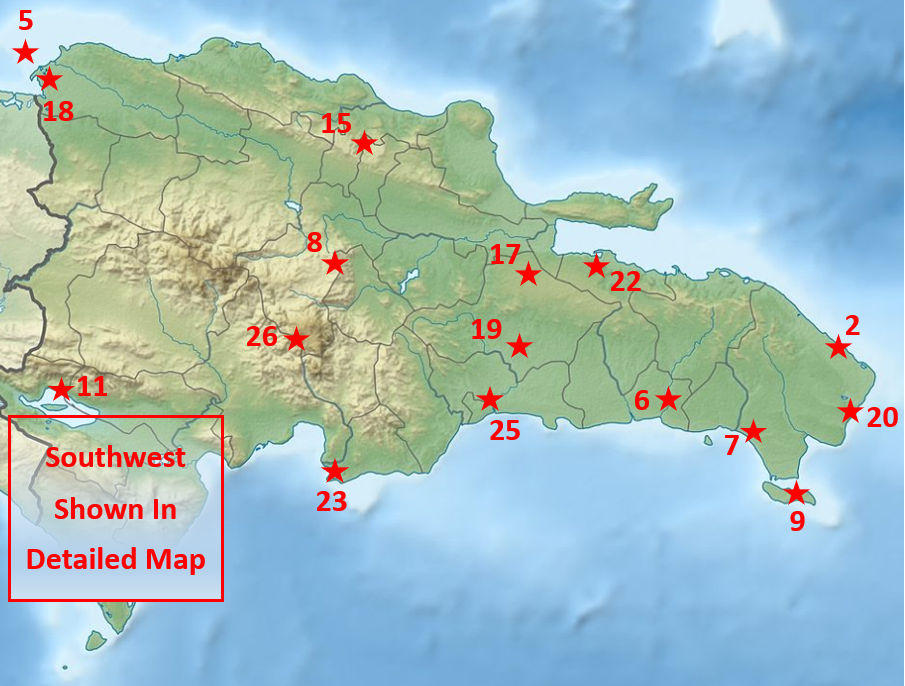
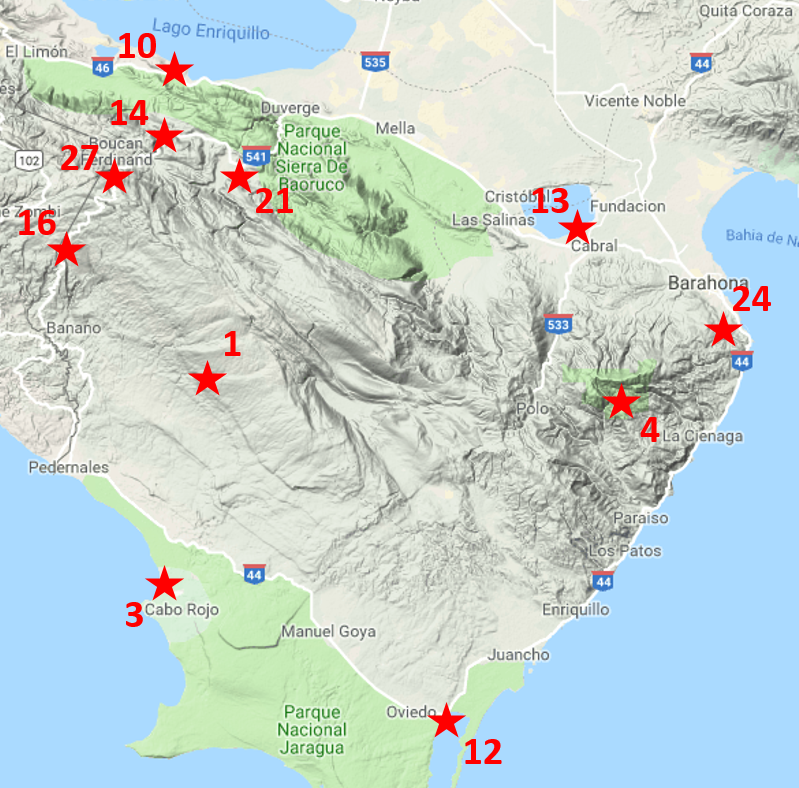
1 – Alcoa Road
2 – Bávaro
3 – Cabo Rojo
4 – Cachote
5 – Cayos Siete Hermanos
6 – Cumayasa
7 – Del Este National Park
8 – Ébano Verde Scientific Reserve
9 – Isla Saona
10 – Lago Enriquillo, South Shore
11 – Lago Enriquillo National Park
12 – Laguna de Oviedo
13 – Laguna de Rincón
14 – La Placa
15 – Loma Quita Espuela
16 – Los Arroyos
17 – Los Limones
18 – Monte Cristi National Park
19 – Monte Plata
20 – Punta Cana Ecological Reserve
21 – Rabo de Gato Trail
22 – Sabana de la Mar
23 – Salinas de Baní
24 – Santa Elena Road
25 – National Botanical Garden
26 – Valle Nuevo National Park
27 – Zapotén
